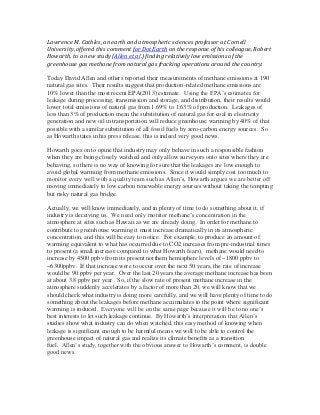
Lawrence Cathles of Cornell Reacts to Criticism of a New Fracking Study
- 1. Lawrence M. Cathles, an earth and atmospheric sciences professor at Cornell University, offered this comment for Dot Earth on the response of his colleague, Robert Howarth, to a new study (Allen et al.) finding relatively low emissions of the greenhouse gas methane from natural gas fracking operations around the country: Today David Allen and others reported their measurements of methane emissions at 190 natural gas sites. Their results suggest that production-related methane emissions are 10% lower than the most recent EPA(2013) estimate. Using the EPA’s estimates for leakage during processing, transmission and storage, and distribution, their results would lower total emissions of natural gas from 1.69% to 1.63% of production. Leakages of less than 3% of production mean the substitution of natural gas for coal in electricity generation and new oil in transportation will reduce greenhouse warming by 40% of that possible with a similar substitution of all fossil fuels by zero-carbon energy sources. So as Howarth states in his press release, this is indeed very good news. Howarth goes on to opine that industry may only behave in such a responsible fashion when they are being closely watched and only allow surveyors onto sites where they are behaving, so there is no way of knowing for sure that the leakages are low enough to avoid global warming from methane emissions. Since it would simply cost too much to monitor every well with a quality team such as Allen’s, Howarth argues we are better off moving immediately to low carbon renewable energy sources without taking the tempting but risky natural gas bridge. Actually, we will know immediately, and in plenty of time to do something about it, if industry is deceiving us. We need only monitor methane’s concentration in the atmosphere at sites such as Hawaii as we are already doing. In order for methane to contribute to greenhouse warming it must increase dramatically in its atmospheric concentration, and this will be easy to notice. For example, to produce an amount of warming equivalent to what has occurred due to CO2 increases from pre-industrial times to present (a small increase compared to what Howarth fears), methane would need to increase by 4500 ppbv from its present northern hemisphere levels of ~1800 ppbv to ~6300ppbv. If that increase were to occur over the next 50 years, the rate of increase would be 90 ppbv per year. Over the last 20 years the average methane increase has been at about 3.8 ppbv per year. So, if the slow rate of present methane increase in the atmosphere suddenly accelerates by a factor of more than 20, we will know that we should check what industry is doing more carefully, and we will have plenty of time to do something about the leakages before methane accumulates to the point where significant warming is induced. Everyone will be on the same page because it will be to no one’s best interests to let such leakage continue. By Howarth’s interpretation that Allen’s studies show what industry can do when watched, this easy method of knowing when leakage is significant enough to be harmful means we will to be able to control the greenhouse impact of natural gas and realize its climate benefits as a transition fuel. Allen’s study, together with the obvious answer to Howarth’s comment, is double good news.
